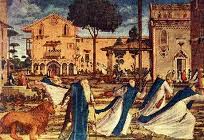In the days of the Republic, one of the five dates on which a state banquet was held, “when the newly-elected members of the Council of Ten took their seats, the Doge entertained them with a banquet, and there were great popular rejoicings over an affair in which the people had no interest.” (W.D. Howells ‘Venetian Life’, 1867)
The other four dates for state banquets are 25th April (St. Mark), 15th June (St. Vitus), 26th December (St. Stephen), and Ascension Day (forty days after Easter).
St Jerome, an early church father (c.347-420 AD) and translator of the Bible into Latin, has always had a good press, mainly due to his noted kindness to lions. Carpaccio’s brief sequence in San Giorgio degli Schiavoni in particular ‘vaut le detour’ and Randall Jarrell’s poem is also worth hunting out “Each day brings its toad, each night its dragon…” (there is a whole book on its composition, edited by his widow Mary: ‘Jerome, The Biography of a Poem’).The church of San Girolamo in Cannaregio on the other hand has little to recommend it. Suppressed with its adjacent monastery in 1806, it saw service as a steam mill and a glucose factory before being acquired by the Dorothean Sisters in 1930 and reopening for worship, after prolonged restoration, in 1952. Unsurprisingly, given its history, the interior contains nothing of interest and the great blank whitewashed wall flanking the eponymous canal had its most felicitous aspect when a cladding of scaffolding for a recent replastering and painting had it briefly recalling the Centre Pompidou.
On this day, in 1659, the 103rd Doge, Giovanni Pesaro, was gathered to his fathers, following a brief reign of a year and a half. After an early career marked by cowardice and embezzlement he was elected doge after pledging 6000 ducats of his own money to the ongoing Cretan campaign against the Turks (lost in any case under the next doge). His “enormous and repellent tomb” in the Frari “has grotesque details, including a camel, giant negroes, and skeletons, and it was designed by the architect of Santa Maria della Salute [Longhena], who ought to have known better.”
(E.V.Lucas – A Wanderer in Venice, 1914)





